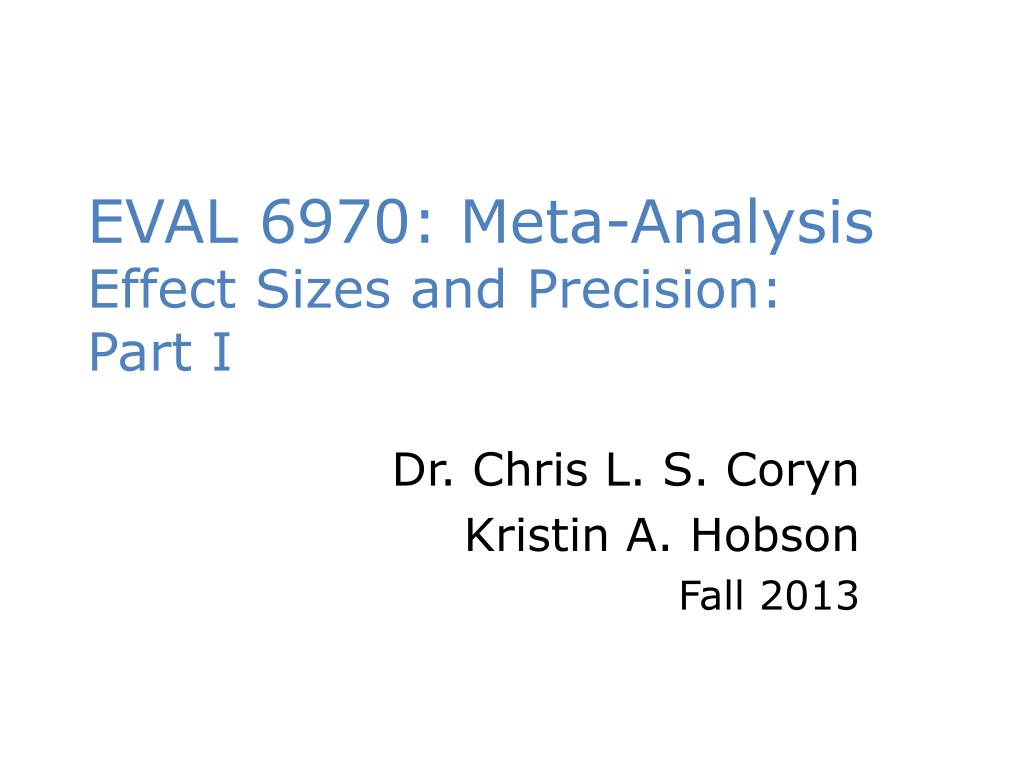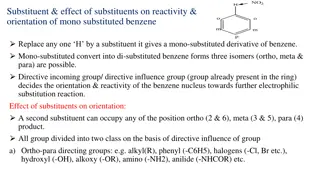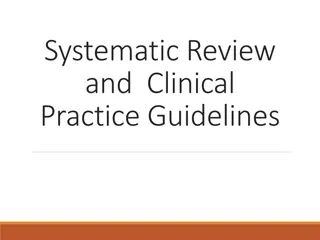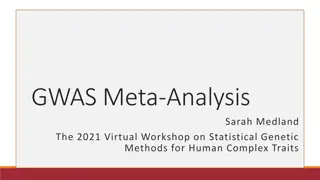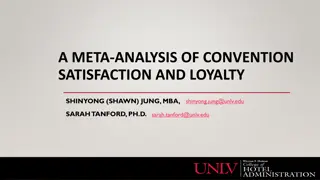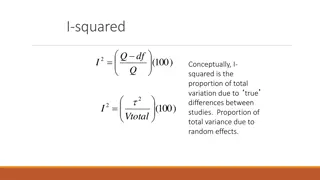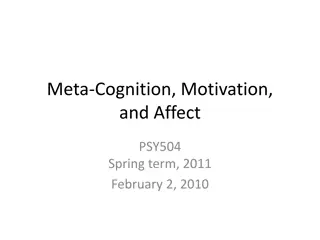EVAL 6970: Meta-Analysis
Delve into the concepts of effect sizes and precision in meta-analysis, covering various statistical notations, raw mean differences, independent and dependent group analyses. Understand the nuances between including different outcome measures, utilizing raw mean difference for meaningful outcomes, and estimating variances and standard errors in different study designs.
Download Presentation

Please find below an Image/Link to download the presentation.
The content on the website is provided AS IS for your information and personal use only. It may not be sold, licensed, or shared on other websites without obtaining consent from the author.If you encounter any issues during the download, it is possible that the publisher has removed the file from their server.
You are allowed to download the files provided on this website for personal or commercial use, subject to the condition that they are used lawfully. All files are the property of their respective owners.
The content on the website is provided AS IS for your information and personal use only. It may not be sold, licensed, or shared on other websites without obtaining consent from the author.
E N D
Presentation Transcript
EVAL 6970: Meta-Analysis Effect Sizes and Precision: Part I Dr. Chris L. S. Coryn Kristin A. Hobson Fall 2013
Agenda Effect sizes based on means Review questions In-class activity
Note Statistical notation varies widely for the topics covered today and in future lectures By convention (and for consistency), we will predominately use Borenstein, Hedges, Higgins, and Rothstein s (2010) notation
The Apples and Oranges Argument: Both are Fruits There is a useful analogy between including different outcome measures in a meta-analysis, the common factor model, multiple- operationism, and concept-to- operation correspondence
Raw Mean Difference, D The raw (unstandardized) mean difference can be used on a meaningful outcome measure (e.g. blood pressure) and when all studies use the same measure The population mean difference is defined as = ?1 ?2
D from Independent Groups The mean difference from studies using two independent groups (e.g., treatment and control) can be estimated from the sample group means ?1and ?2 as ? = ?1 ?2
D from Independent Groups Assuming ?1= ?2= ? (as is assumed for most parametric statistics) the variance of D is ??=?1+ ?2 ?1?2 2 ??????? where 2+ ?2 1 ?2 ?1+ ?2 2 2 ?1 1 ?1 ???????=
D from Independent Groups Assuming ?1 ?2 the variance of D is 2 2 ??=?1 ?1 + ?2 ?2 For both ?1= ?2 and ?1 ?2 the standard error of D is ???= ??
D from Dependent Groups When groups are dependent (e.g., matched pairs designs or pretest- posttest designs) then D is the difference score for each pair ? = ????? or ? = ?1 ?2
D from Dependent Groups Where the variance is 2 ??=????? ? Where n is the number of pairs, and ???= ??
D from Dependent Groups If ????? must be computed 2+ ?2 2 2 ? ?1 ?2 ?????= ?1 Where r is the correlation between pairs If ?1= ?2 then 2 ?????= 2 ??????? (1 ?)
Standardized Mean Difference, d and g Assuming ?1= ?2= ? (as is the case for most parametric statistics) the standardized mean difference population parameter is defined as ? =?1 ?2 ?
d and g from Independent Groups The standardized mean difference (?) from independent groups (e.g., treatment and control) can be estimated from the sample group means ?1and ?2 as ?1 ?2 ???? ?? ? =
d and g from Independent Groups Where ???? ?? is the within-groups standard deviation, pooled across groups 2+ (?2 1)?2 ?1+ ?2 2 2 ?1 1 ?1 ???? ??=
d and g from Independent Groups Where the variance is ?2 ??=?1+ ?2 + ?1?2 2(?1+ ?2) And the standard error is ???= ??
d and g from Independent Groups In small samples (N < 20), d overestimates ? and this bias can be reduced by converting dto Hedges g using the correction factor J, where 3 ? = 1 4?? 1 For two independent groups ?? = ?1+ ?2 2
d and g from Independent Groups Using the correction factor J, Hedges g is calculated as ? = ? ? With ??= ?2 ?? And ???= ??
d and g from Dependent Groups When groups are dependent (e.g., matched pairs designs or pretest- posttest designs) then d is the difference score for each pair ????? ???? ?? ?1 ?2 ???? ?? ? = =
d and g from Dependent Groups Where ???? ?? is ????? ???? ??= 2(1 ?)
d and g from Dependent Groups Where the variance is 1 ?+?2 ??= 2(1 ?) 2? Where n is the number of pairs, and ???= ??
d and g from Dependent Groups If ????? must be computed 2+ ?2 2 2 ? ?1 ?2 ?????= ?1 Where r is the correlation between pairs If ?1= ?2 then 2 ?????= 2 ??????? (1 ?)
d and g from Dependent Groups In small samples (N < 20), d overestimates ? and this bias can be reduced by converting dto Hedges g using the correction factor J, where 3 ? = 1 4?? 1 Where, in dependent groups ?? = ? 1
d and g from Dependent Groups Using the correction factor J, Hedges g is calculated as ? = ? ? With ??= ?2 ?? And ???= ??
Effect Direction For all designs the direction of the effect ( ?1 ?2 or ?2 ?1) is arbitrary, except that the same convention must be applied to all studies in a meta-analysis (e.g., a positive difference indicates that the treated group did better than the control group)
Review Questions 1. When is it appropriate to use D? 2. When is it appropriate to use d? 3. When is it appropriate to use g?
Todays In-Class Activity Individually, or in your working groups, download Data Sets 1-6 XLSX from the course Website Calculate the appropriate effects sizes, standard deviations, variances, and standard errors for Data Sets 1, 2, 3, and 4 Be certain to save your work as we will use these data again
